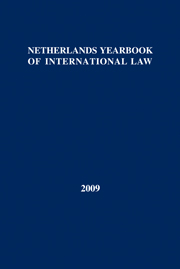Article contents
Some thoughts on the future of the International Court of Justice *
Published online by Cambridge University Press: 07 July 2009
Extract
For some years the future of the International Court of Justice has been a matter of growing concern to supporters of international adjudication as a way of settling legal disputes between States. This concern has also made itself felt inside the Organization of the United Nations, where the review of the role of the Court was a standing item on the agenda of the General Assembly for a number of years until the adoption on 22 November 1974 of resolution 3232 (XXIX). In this resolution the General Assembly inter alia expressed its satisfaction with the Court's 1972 revision of its Rules, and called upon States to have recourse to the Court more often.
- Type
- Articles
- Information
- Copyright
- Copyright © T.M.C. Asser Press 1975
References
1. International Court of Justice, Yearbook 1973–1974 (No. 28) p. 49.Google Scholar
2. Nuclear Tests Cases (Australia v. France and New Zealand v. France).
3. Journal Officiel de la République Francaise, 9 March 1974, pp. 1086–1087.Google Scholar
4. Text of the revised Rules in: International Court of Justice, Acts and Documents concerning the Organization of the Court, No. 2 (1972). Also in: 67 A.J.I.L. (1973) pp. 195 et seq.; 11 I.L.M. (1972) pp. 899 et seq.
5. Art. 26.
6. Art. 24 of the Rules.
7. Art. 26 of the revised Rules reads: “… (1) When the Court, acting under Article 26, paragraph 2, of the Statute decides, at the request of the parties, to form a Chamber to deal with a particular case, the President shall consult the agents of the parties regarding the composition of the Chamber, and shall report to the Court accordingly. (2) When the Court has determined, with the approval of the parties, the number of its Members who are to constitute the Chamber, it will proceed to their election, in accordance with the provisions of Article 27, paragraph 1, of these Rules. The same procedure shall be followed as regards the filling of any vacancy that may occur on the Chamber. (3) Any member of a Chamber formed under this Rule who ceases to be a Member of the Court by reason of the expiry of his term of office, shall continue to sit in the case, whatever the stage reached when his term of office expires…”.
8. See the separate opinion of the present writer in the Case Concerning the Legal Consequences, for States of the Continued Presence of South Africa in Namibia (S.W. Africa) Notwithstanding Security Council Resolution 276 (1970), I.C.J. Reports 1971, p. 130.
9. G.A.O.R. 29th session, Suppl. No. 1 A (A/9601/Add.1) p. 8.
10. Gross, L. (ed.), The Future of the International Court of Justice, to be published in 1975 (Oceana, N.Y.).Google Scholar
11. I.C.J. Reports 1974, p. 1 et seq.
12. Prott, Lyndel V., “The rôle of the judge of the International Court of Justice, 10 Revue Belge de Droit International (1974) pp. 473–507.Google Scholar
13. Such as in the Fisheries Jurisdiction (U.K. v. Iceland and Federal Republic of Germany v. Iceland) cases, the Nuclear Tests (Australia and New Zealand v. France) cases, and the Case concerning Trial of Pakistani Prisoners of War (Pakistan v. India).
14. See supra n. 13.
15. See Informal Single Negotiating Text, presented at the end of the Geneva session of the Third UN Conference on the Law of the Sea by the Chairmen of the three main committees, A/Conf.62/WP. 8 of May, 1975.
- 1
- Cited by


